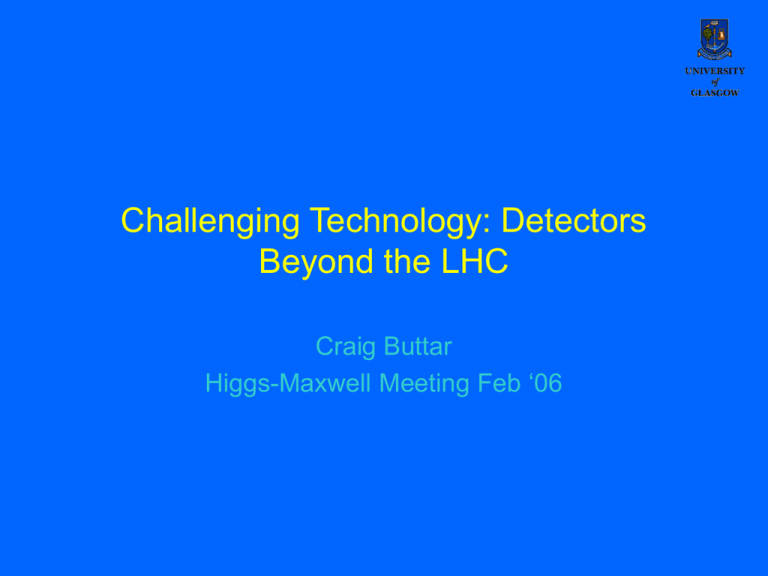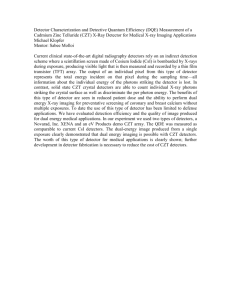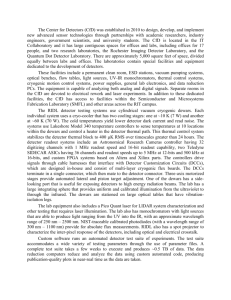Challenging Technology: Detectors Beyond the LHC Craig Buttar Maxwell Meeting Feb ‘06
advertisement

Challenging Technology: Detectors Beyond the LHC Craig Buttar Higgs-Maxwell Meeting Feb ‘06 Examples – ATLAS SCT Future of Particle Physics in a nutshell • Luminosity upgrade of LHC (sLHC) – H self couplings precision tracking in high multiplicity environment – Radiation hardness x10 cf LHC – Large scale production • LHCb upgrade – Velo replacement required after 3 years – LHCb data taking limited to 1/50th of design luminosity – Make better use of LHC luminosity improve rare decay limits test new physics • Precision physics at ILC – Higgs couplings, SUSY (Higgs) mass spectrum…….. – High resolution vertexing for flavour tagging – High resolution tracking calorimetry based on energy flow • The neutrino sector – Unravelling the neutrino mass matrix – Large scale detectors – Beam systematics sLHC Luminosity upgrade for ATLAS-SCT Tracking and b-tagging Design issues • layout • occupancy • radiation damage 50mm pitch Neutron 65% Pion 29% Proton 6% Neutron 18% Pion 74% Proton 8% Neutron 66% Pion 25% Proton 7% Pixels: r=6cm, 15cm, 24cm Ministrips: r=35cm, 48cm, 62cm Microstrips: r=84cm, 105cm Si technologies for sLHC • Si Traditionally use p-in-n detectors but cannot operate underdeplented • Use n-in-p as no type inversion n-in-p 7000e- P-type 1cm detector after 7.5×1015p cm-2 ≈4.5×1015 1MeV neqcm-2 (850V) – Production issues – HV required, careful design to avoid breakdown • Use Cz based n-type Si – Does not invert (?) – Now a common material in Si manufacture – Harder to charged particles best for intermediate radii or pixels Ionisation in oxidehigh field regions + P ++ -current from + + -cut edges Displacement damage cluster np; increased dark current guard region Detector region SLHC R=40cm SLHC R=20cm P-type Si ionisationsignal CCE is now an issue W3D~20mm W2D~300mm SiO 2 +ve -ve +ve 3D detectors p+ h+ h+ Bulk n e- e- W3D E n+ +ve E W2D • 3D uses MEMS technology to engineering Si structures – Smaller detector ‘cells’ Lower depletion voltages Faster and more efficient charge collection BUT small-scale suitable for LHCb upgrade For 4.5 x 1014 24GeV/c p/cm2 (2.7 x 1014 1MeV n/cm2) 2 years LHCb Velo inner radius Depletion voltage = 19V Type inversion observed Other issues for sLHC • Cooling – Thermal runaway: I Power dissipation T • Large scale production – SCT area 60m2 210m2 – Electronics 6M 60M channels – Need close links with industry for mass production of components and assembly? Flux 2E15, bias 800, width 9cm -20 Temperature (degC) – To avoid thermal runaway need to have edges a -30oC to dissipate heat and keep temp low – Current technology has a coolant temperature of ~-30oC to give –7oC at LHC – Low mass cooling with robust minimum mass pipes -44 degC -25 -42 degC -30 -40 degC -35 -38 degC -36 degC -40 -34 degC -45 -32 degC 0 2 4 x (cm) 6 8 -30 degC LHCb upgrade triggering at LHC lumi • Factor five higher lumi Cope 3-4 interactions per beam crossing • Muon trigger fine – 4 of 10 benchmark channels have m+m- in final state • Hadron Trigger bandwidth saturates – Need displaced track trigger at first trigger level 8 FPGA based Triggering system – Pattern recognition / tracking – Primary Vertex Identification – Displaced Track Trigger – 4ms latency Vertex detectors for ILC • Physics requirements – Identify b and c-jets and jet-charge – Momentum resolution s(1/pT) at 100GeV ~4-5TeV-1 (ATLAS 100TeV-1) important for energy flow—see later • Detector requirements – Very low mass – High resolution sip~3mm ~20mm pixels ~109 channels reduces occupancy – Beam structure readout every 50ms ~20 times during 1ms train • Data readout – possible em interference • Data stored -- readout during ~0.2 between bunches – Radiation hardness less of an issue • CCDs ILC vertex detectors – Used in linear collider at SLAC -- SLD – Precision but readout speed is slow as reading out each column and then row – Readout each column – CPCCD • First prototypes CPC1 by LCFI – Readout at 25MHz – RF pickup from beam is a worry! CPC1 RO chip (Bump bonding Packaging and interconnects) Detectors with storage ISIS and MAPS • ISIS – In-situ Storage Image Sensor – Store charge in 20-element CCD – Readout during 0.2s between bunches – Solves potential RF problem and is more radiation hard – But processing has to be demonstrated • Monolithic Active Pixel sensors – CMOS imaging technology – Smaller active volume – Requires development of on-chip memory Slab Slab x5000 Slab Slab 30% best achieved at E Slab s – Requires LEP 60% E Slab • Need to resolve W and Zs Slab Calorimetry for the ILC 5000 fibres 1Gb E – Need to measure energy flow in the event • Match charged tracks to clusters • Measure neutral clusters in calorimeter • good spatial resolution – more important than energy resolution! Large Network Switch/s 5Tb 10Gb Event Event Event Builder Builder Builder PC PC PC x250 Target Control Event Builder PC Busy – Leads to a number of technical issues • Readout density and getting data out of the calorimeter: 0.3-3GBytes/s per ASIC, 200TByte/s total ECAL • Achieving the required spatial resolution -- MAPS • Managing the thermal load VFE chip Cooling Si Wafers PCB Tungsten 8.5mm Neutrino factory • Golden channel muon appearance • Requires MINOS like detectors but x10 larger • The large volume leads to problems with reading out scintillator (~10m) m 50% 50% e detector m m e e m m wrong sign muon Large Magnetic Detector 20 m beam • But need to understand the beam! 40KT B=1 T 20 m iron (4 cm) + scintillators (1cm) Neutrino factory • Near detector – Need to measure flux and charm background rates for measurements at far detector – Use active target – Large area coverage required (18 layers covering 50x50cm2 – Use MAPS • 2D readout • Cheap large area coverage Si tracker in NOMAD Not covered • Development of technologies for PP is as active as ever • Too many to cover! • Some topics not covered (still only a selection) – – – – Rad-hard readout chips for sLHC Development of ionisation cooling for nufact – MICE @ RAL Fast feedback systems for ILC to optimise luminosity Low background detectors for Dark Matter searches and neutrinoless double beta decay – Precision physics at LHC (FP420): Small scale tracking detectors able probe the edge of the beam – ….. Other applications • Particle physics technology has found applications in – Radiotherapy – Imaging Medipix1 2 mm Imaging plate Medipix2 Summary and conclusions • Future Particle Physics experiments has many challenges for detectors and systems – – – – – – – Rad-hardness Speed Precision Large scale production Connections System building detectors+readoutmodulessubsystems Data handling Backup LHCb Upgrade – Why ? • LHCb uses only 1/50th of LHC design luminosity – Average of one interaction per beam crossing – Limit Radiation damage • Many physics results would benefit from higher luminosity, e.g. – Rare B decays • Clear Benefit • e.g. Bsm+m– SM BR 3.5 x 10-9 , 3.7 s after 3 (107 second) years – • Not theoretically limited after 3 (107 second) years • More (clean) events would help ! LHCb Upgrade -Technically Feasible? • Radiation Hard Silicon Technology Developed •Czochralski Silicon •n-on-p •3D detectors •Hybrid Pixels Construct a Vertex Detector with •better proper time resolution •withstand 10 times more radiation damage First Velo need replacement ~ 2011 VEtex LOcator Priority only if large Dms 1015 1 MeV neutron equiv. /cm2 VELO Superior Performance Apparatus •New Triggering Strategy • Factor five higher lumi Cope 3-4 interactions per beam crossing • Muon trigger fine – 4 of 10 benchmark channels have m+m- in final state • Hadron Trigger bandwidth saturates – Need displaced track trigger at first trigger level 8 FPGA based Triggering system – Pattern recognition / tracking – Primary Vertex Identification – Displaced Track Trigger – 4ms latency Plan • Rad. Hard Sensors being produced •6” mask designed •MCz, n-on-p, pixels • Prototype VELO modules and Trigger 2009 • Upgraded VELO & displaced vertex trigger 2011 Physics case for future neutrino facilities • Neutrino oscillations for atmospheric, solar, reactor neutrinos provide fit to q23, q12, Dm122 and Dm232 • Need more experiments for q13, mass hierarchy and CP violation phase d Super-beams • Super-beams (ie. JPARC beam for T2K) provide monochromatic Flux • s (arbitrary unit) off-axis neutrino beams for e appearance 2.5o q =2o 2 Flux 2 2 1 q 3o 0 q=0o 1 T2K 2 2 E (GeV) • Proposals for super-beams with ~ Mton Water Cherenkov detectors (Memphys in Frejus, HyperKamiokande Japan, UNO in USA) Goal T2K: down to q13~2-30 • Beta-beam facility 6 2 He 36Li e e 18 10 Ne F νe e 18 9 • Neutrino factory: CERN layout: Emax~ 600 MeV Beta-beams and neutrino factories High-energy part Low-energy part Neutrino source Acceleration Ion production Proton Driver 6He: 18Ne: Ion production ISOL target & Ion source = 100 = 100 Neutrino Source Beam preparation ECR pulsed SPS Ion acceleration Linac Acceleration to medium energy RCS PS m e m e m e m e Decay Ring Oscillation signatures • Golden channel at a NuFact: “wrong-sign” muons detector m 50% e 50% m m m e m wrong sign muon • Silver channel: tau appearance Pb Emulsion layers beam 40KT 1 mm 20 m Emulsion (4 kton) Plastic base Large Magnetic Detector e e m B=1 T 20 m iron (4 cm) + scintillators (1cm) e Liquid Argon (100 kton) (kinematic selection ) Near Detector • Near detector: control flux, systematics, maeasure crosssections, charm backgrounds for oscillation signals, …. m CC event • Use silicon detectors for vertex (prototype in NOMAD) • 109 interactions per year in 50 kg!!! • Monolithic Active Pixel (MAPS): fully active neutrino target Physics reach neutrino factory • Sensitivity to d-q13: best for neutrino factory (except at high q13, in which matter effects dominate). P. Huber et al. High- b beam not included Performance comparable to Nufact (Burget et al.) First oscillation maximum only Introduction to 3D detectors • Co-axial detector – Arrayed together • Micron scale – USE Latest MEM techniques • Pixel device – Readout each p+ column • Strip device – Connect columns together Proposed by S.Parker NIMA 395 pp. 328-343(1997). Operation SiO2 +ve -ve -ve +ve -ve -ve p+ h+ h+ Bulk n - e W3D E e- W2D n+ Equal detectors thickness W2D>>W3D +ve E Carriers drift total Carriers swept horizontally thickness of material Travers short distance between electrodes • Low full depletion bias • Low collection distances High CCE • Fast Two methods to form pores DRIE Electro-chemical etching •So far, maximum aspect ratio: 18:1 (depth 183μm) •Modification to standard equipment to obtain deep narrow parallel walled pores •In conjunction with STS • maximum aspect ratio: 30:1 (depth 440 μm, =14 μm) • 24 hours per wafer • Cheap Results - IV of devices • Good rectifying np junction formed • Oxide as diffusing barrier isolates individual cells • RIE removal of top surface caused increase in current after -10V Glasgow 3D detector Results - Proton irradiation High res n-type silicon, 85mm pitch, close-packed hexagonal pixels Irradiation with 24 GeV/c protons at CERN 7 fluences from 5 x 1012 to 4.5 x 1014 24GeV/c p /cm2 For 4.5 x 1014 24GeV/c p/cm2 (2.7 x 1014 1MeV n/cm2) 2 years Velo inner radius Depletion voltage = 19V Type inversion observed 3D-stc detectors proposed at ITC-irst [2] For fab simplification n+ electrodes 50 mm p-type substrate n + electrodes 0V + potential distribution -5 V -5V - - + - - + vertical cross-section between two electrodes --patterned Uniform p+ layer 0V -8 V -8V Uniform/grid - -20 V electrons are swept away by the transversal field holes drift in the central region and diffuse towards p+ contact ionizing particle Recently, Semi-3D radiation detectors with p+ columns in n-type substrates were proposed by Eränen et al. [3] C. Piemonte, M. Boscardin, G.-F. Dalla Betta, S. Ronchin, N. Zorzi, Nucl. Instr. Meth. Phys. Res. A 541 (2005) 441 [3] S. Eränen, T. Virolainen, I. Luusua, J. Kalliopuska, K.Kurvinen, M. Eräluoto, J. Härkönen, K. Leinonen, M. Palviainen and M. Koski, 2004 IEEE Nuclear Science Symposium, Conference Record, paper N28-3, Rome (Italy), October 16-22, 2004 [2] Mask Layout-Test structures Standard (planar) test structures 10x10 matrix Ø hole 10 µm 44 holes GR p-stop 20 µm Ø implant 44 µm 3D-Diode Pitch 80 µm Backplane full-depletion-voltage Preliminary “3d-diode”/back capacitance measurements D4_4 10 Cdiode [pF] Lateral depletion contribution to measured capacitance at low voltages 12 C-V 8 6 4 2 Linear 1/C2 vs V region corresponding to the same doping level of planar diodes 0 0 2.50 Column depth ~ 150µm 2.00 C -2 -2 [pF ] Saturation capacitance corresponding to a depleted width of ~ 150µm) 10 20 30 Vrev [V] 40 50 60 1.50 1.00 1/C2-V 0.50 0.00 0 10 20 30 Vrev [V] 40 50 60 ~ 40V full depletion voltage (300µm wafer) S/N for HEPAPS2 Test beam at HERA FAPS: RAL group • FAPS could be extended to a full 20 samples per train, stored in pixel • If this doesn’t fit with 0.25 mm CMOS, will surely be OK with 0.13 mm • Idea is to relax the requirement for fast, precise, signal transmission to chip periphery during train, and so render long columns feasible, with all processing logic outside the detector active volume, as for the CCD architecture • Test devices implemented using a 0.25 mm process – TSMC(imaging) FAPS resolution 13um hit resolution



